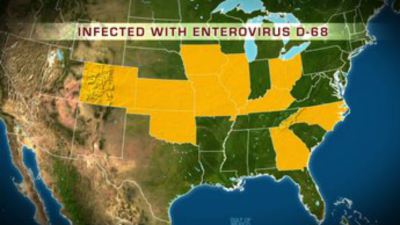It’s an annual rite: school begins, viruses spread and the kids bring home a bug. We all expect our kids to catch some type of germ in early September, but we don’t ever think we’ll have to send them to the hospital, or that they’ll become so sick they’ll need intensive care and oxygen.
But that’s what’s happening in several states. Thousands of children across the Midwest have been sent to the hospital with a severe respiratory virus. Researchers say that the high number of children needing hospital care may only be the “tip of the iceberg” and are warning the concerned public that they don’t yet know why this particular enterovirus outbreak is so severe.
Ten states have contacted the Centers for Disease Control for assistance in investigating clusters of enterovirus: Colorado, North Carolina, Georgia, Ohio, Iowa, Illinois, Missouri, Kansas, Oklahoma, and Kentucky. In Kansas City, Missouri, hundreds of children have been sent to the hospital, with some 15% needing to be placed in intensive care units, say officials. Mary Anne Jackson, Children’s Mercy Hospital director of infectious diseases, says she’s “never seen anything like this” in the 30 years she’s practiced pediatrics.
Enteroviruses are a diverse group of viruses that affect millions of people worldwide each year and have a high mutation rate. The most common ones resemble symptoms of an intense cold, such as coughing and difficulty breathing, which may be worse in those who suffer from asthma. Doctors say the virus can be accompanied by a rash, fever and wheezing. Often described as a summer cold, some enteroviruses typically peak just in time for the beginning of the school year.
This particular enterovirus, known as EV-D68, is a distant cousin of the polio virus. The chief symptom of the virus, as it progresses, is difficulty breathing. The virus was first identified in the 1960s but has not been very common until now with only a few reported cases identified since that time, mostly in clusters in the U.S. and overseas. There is no vaccine for the virus and no specific treatment; doctors have been effectively treating it with supportive care, including the administration of oxygen. So far, some 30 children have shown positive test results for EV-D68.
None of the recent cases in Kansas City or in other parts of the U.S. have proven fatal to date.
“All of these folks are going to get better,” says William Schaffner, head of the Department of Preventive Medicine at Vanderbilt University. “Some of them have more severe illness, such as those children who have developed asthma and are hospitalized. But they should all get better.”
EV-D68 is mostly affecting a 1,000-mile stretch in the Midwest, starting in Ohio and reaching as far as Colorado. In Denver, dozens of children have been hospitalized with symptoms thought to be caused by the virus and another 900 have been treated, according to reports. One Denver child, a 13-year-old who suffers from asthma, was found unconscious and barely breathing last week according to a local television stationin Denver. His parents said they thought he had a common cold not long before.
Doctors are giving standard advice when asked how to mitigate the chances of EV-D68 infection. Washing your hands frequently with soap and water, disinfecting frequently touched surfaces, and avoiding direct physical contact with other people are the best ways to avoid infection.
[amazon template=iframe image&asin=1555810926,B003M68YDY,B00KCWKYES,384335698X,B00KCWLAKU,1288393423,712106524X,9578230060,1600213391,B00KCWDWGA,B000PC0GPC,B00KCWQQFO]






